MBA501: Business Portfolio and Dynamic Capability Analysis Report
VerifiedAdded on 2023/06/04
|7
|1475
|353
Report
AI Summary
This report provides a comprehensive analysis of Australian Vintage's business portfolio and dynamic capabilities. It begins with a business portfolio analysis, utilizing the BCG matrix, GE-McKinsey matrix, and Synergy Matrix to evaluate the performance of McGuigan, Nepenthe, and Tempus Two brands. The report recommends resource allocation strategies based on these matrices, suggesting further development of Tempus Two and Nepenthe. Following this, a dynamic capability analysis assesses Australian Vintage's ability to sense market opportunities, seize resources, and transform strategic assets. The analysis highlights the company's need to invest more in research and development to maintain market leadership. The report concludes with recommendations for enhancing dynamic capability through increased investment in R&D, mobilization of resources, and leveraging human and financial assets. The report is supported by a bibliography of relevant sources.
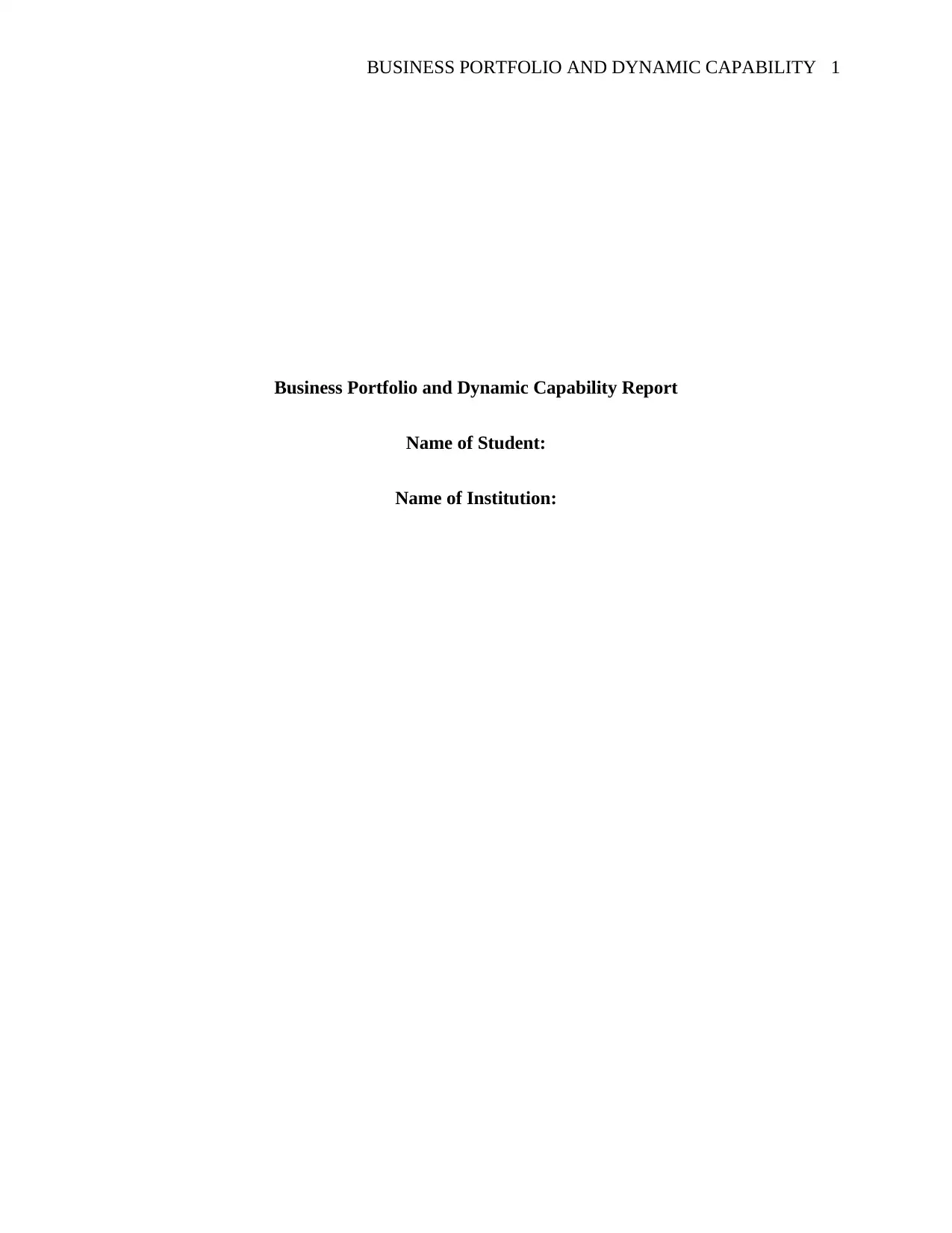
BUSINESS PORTFOLIO AND DYNAMIC CAPABILITY 1
Business Portfolio and Dynamic Capability Report
Name of Student:
Name of Institution:
Business Portfolio and Dynamic Capability Report
Name of Student:
Name of Institution:
Paraphrase This Document
Need a fresh take? Get an instant paraphrase of this document with our AI Paraphraser
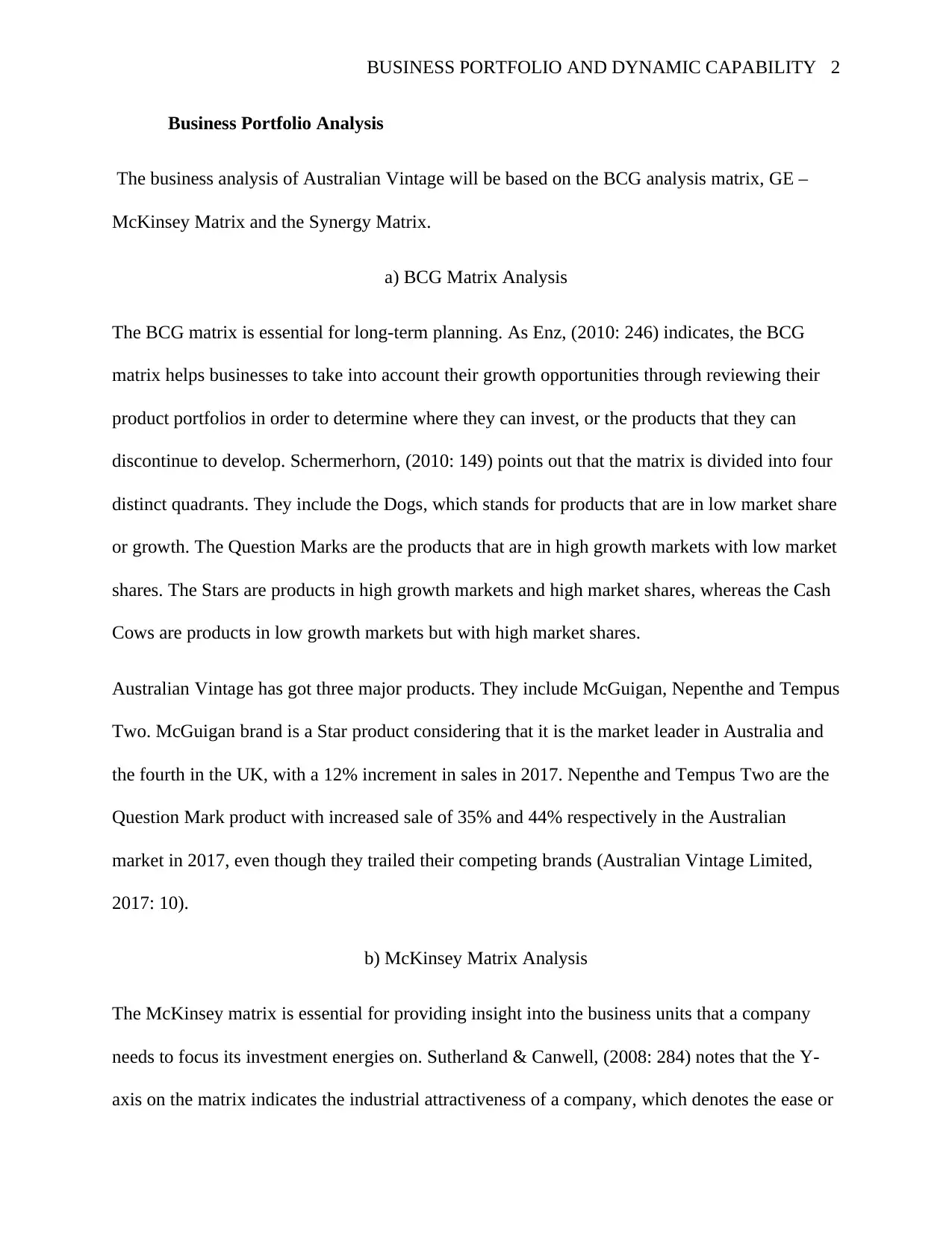
BUSINESS PORTFOLIO AND DYNAMIC CAPABILITY 2
Business Portfolio Analysis
The business analysis of Australian Vintage will be based on the BCG analysis matrix, GE –
McKinsey Matrix and the Synergy Matrix.
a) BCG Matrix Analysis
The BCG matrix is essential for long-term planning. As Enz, (2010: 246) indicates, the BCG
matrix helps businesses to take into account their growth opportunities through reviewing their
product portfolios in order to determine where they can invest, or the products that they can
discontinue to develop. Schermerhorn, (2010: 149) points out that the matrix is divided into four
distinct quadrants. They include the Dogs, which stands for products that are in low market share
or growth. The Question Marks are the products that are in high growth markets with low market
shares. The Stars are products in high growth markets and high market shares, whereas the Cash
Cows are products in low growth markets but with high market shares.
Australian Vintage has got three major products. They include McGuigan, Nepenthe and Tempus
Two. McGuigan brand is a Star product considering that it is the market leader in Australia and
the fourth in the UK, with a 12% increment in sales in 2017. Nepenthe and Tempus Two are the
Question Mark product with increased sale of 35% and 44% respectively in the Australian
market in 2017, even though they trailed their competing brands (Australian Vintage Limited,
2017: 10).
b) McKinsey Matrix Analysis
The McKinsey matrix is essential for providing insight into the business units that a company
needs to focus its investment energies on. Sutherland & Canwell, (2008: 284) notes that the Y-
axis on the matrix indicates the industrial attractiveness of a company, which denotes the ease or
Business Portfolio Analysis
The business analysis of Australian Vintage will be based on the BCG analysis matrix, GE –
McKinsey Matrix and the Synergy Matrix.
a) BCG Matrix Analysis
The BCG matrix is essential for long-term planning. As Enz, (2010: 246) indicates, the BCG
matrix helps businesses to take into account their growth opportunities through reviewing their
product portfolios in order to determine where they can invest, or the products that they can
discontinue to develop. Schermerhorn, (2010: 149) points out that the matrix is divided into four
distinct quadrants. They include the Dogs, which stands for products that are in low market share
or growth. The Question Marks are the products that are in high growth markets with low market
shares. The Stars are products in high growth markets and high market shares, whereas the Cash
Cows are products in low growth markets but with high market shares.
Australian Vintage has got three major products. They include McGuigan, Nepenthe and Tempus
Two. McGuigan brand is a Star product considering that it is the market leader in Australia and
the fourth in the UK, with a 12% increment in sales in 2017. Nepenthe and Tempus Two are the
Question Mark product with increased sale of 35% and 44% respectively in the Australian
market in 2017, even though they trailed their competing brands (Australian Vintage Limited,
2017: 10).
b) McKinsey Matrix Analysis
The McKinsey matrix is essential for providing insight into the business units that a company
needs to focus its investment energies on. Sutherland & Canwell, (2008: 284) notes that the Y-
axis on the matrix indicates the industrial attractiveness of a company, which denotes the ease or
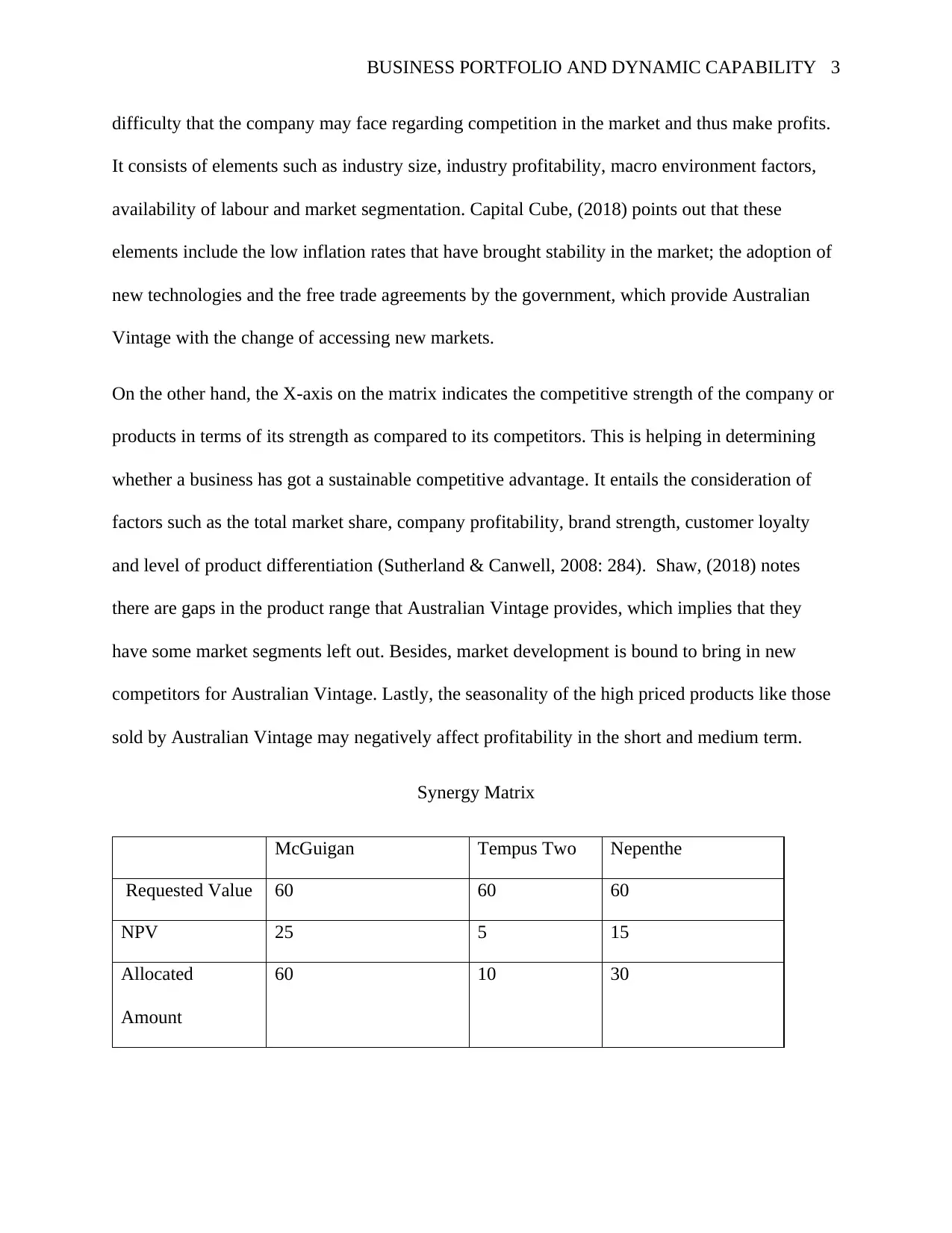
BUSINESS PORTFOLIO AND DYNAMIC CAPABILITY 3
difficulty that the company may face regarding competition in the market and thus make profits.
It consists of elements such as industry size, industry profitability, macro environment factors,
availability of labour and market segmentation. Capital Cube, (2018) points out that these
elements include the low inflation rates that have brought stability in the market; the adoption of
new technologies and the free trade agreements by the government, which provide Australian
Vintage with the change of accessing new markets.
On the other hand, the X-axis on the matrix indicates the competitive strength of the company or
products in terms of its strength as compared to its competitors. This is helping in determining
whether a business has got a sustainable competitive advantage. It entails the consideration of
factors such as the total market share, company profitability, brand strength, customer loyalty
and level of product differentiation (Sutherland & Canwell, 2008: 284). Shaw, (2018) notes
there are gaps in the product range that Australian Vintage provides, which implies that they
have some market segments left out. Besides, market development is bound to bring in new
competitors for Australian Vintage. Lastly, the seasonality of the high priced products like those
sold by Australian Vintage may negatively affect profitability in the short and medium term.
Synergy Matrix
McGuigan Tempus Two Nepenthe
Requested Value 60 60 60
NPV 25 5 15
Allocated
Amount
60 10 30
difficulty that the company may face regarding competition in the market and thus make profits.
It consists of elements such as industry size, industry profitability, macro environment factors,
availability of labour and market segmentation. Capital Cube, (2018) points out that these
elements include the low inflation rates that have brought stability in the market; the adoption of
new technologies and the free trade agreements by the government, which provide Australian
Vintage with the change of accessing new markets.
On the other hand, the X-axis on the matrix indicates the competitive strength of the company or
products in terms of its strength as compared to its competitors. This is helping in determining
whether a business has got a sustainable competitive advantage. It entails the consideration of
factors such as the total market share, company profitability, brand strength, customer loyalty
and level of product differentiation (Sutherland & Canwell, 2008: 284). Shaw, (2018) notes
there are gaps in the product range that Australian Vintage provides, which implies that they
have some market segments left out. Besides, market development is bound to bring in new
competitors for Australian Vintage. Lastly, the seasonality of the high priced products like those
sold by Australian Vintage may negatively affect profitability in the short and medium term.
Synergy Matrix
McGuigan Tempus Two Nepenthe
Requested Value 60 60 60
NPV 25 5 15
Allocated
Amount
60 10 30
⊘ This is a preview!⊘
Do you want full access?
Subscribe today to unlock all pages.

Trusted by 1+ million students worldwide
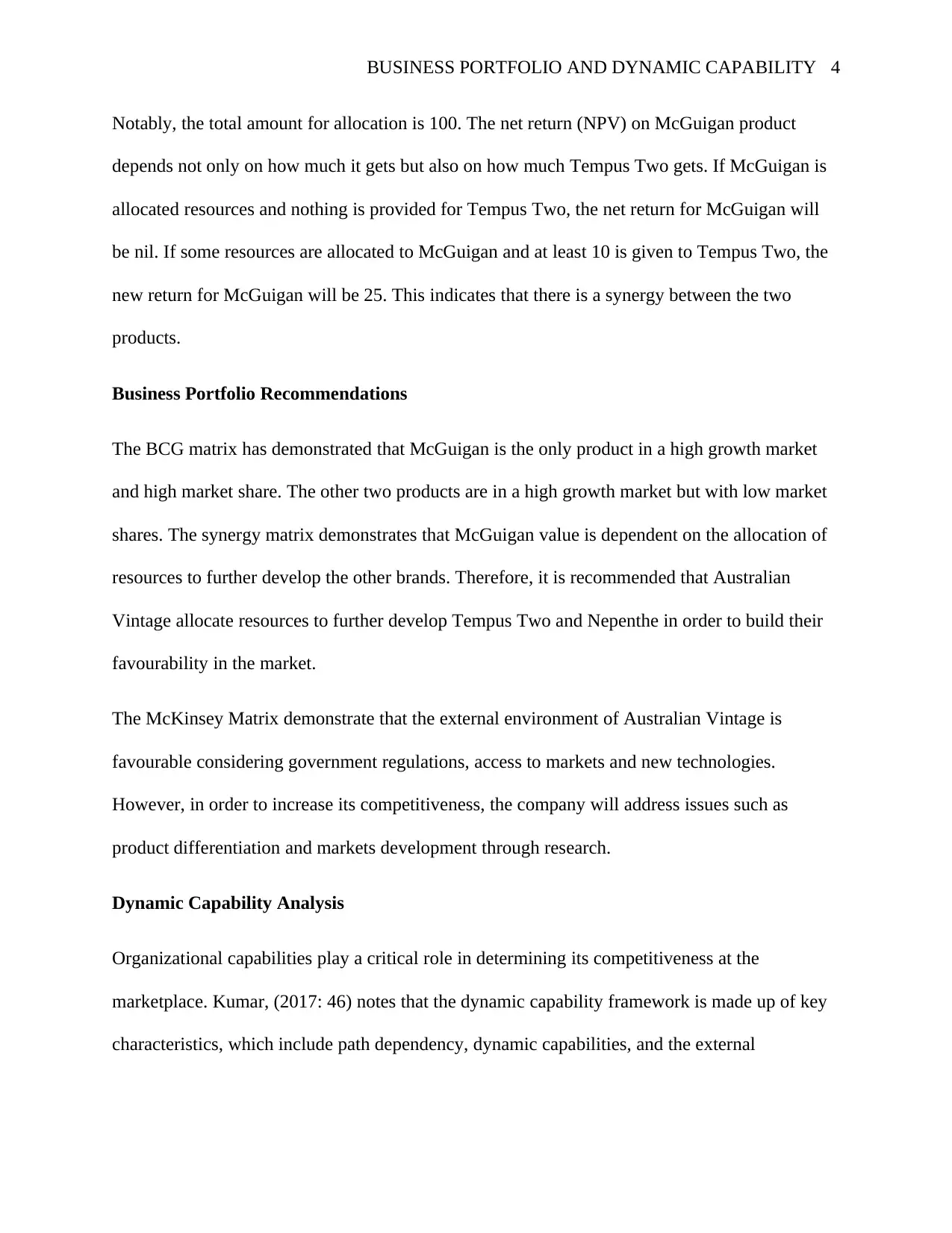
BUSINESS PORTFOLIO AND DYNAMIC CAPABILITY 4
Notably, the total amount for allocation is 100. The net return (NPV) on McGuigan product
depends not only on how much it gets but also on how much Tempus Two gets. If McGuigan is
allocated resources and nothing is provided for Tempus Two, the net return for McGuigan will
be nil. If some resources are allocated to McGuigan and at least 10 is given to Tempus Two, the
new return for McGuigan will be 25. This indicates that there is a synergy between the two
products.
Business Portfolio Recommendations
The BCG matrix has demonstrated that McGuigan is the only product in a high growth market
and high market share. The other two products are in a high growth market but with low market
shares. The synergy matrix demonstrates that McGuigan value is dependent on the allocation of
resources to further develop the other brands. Therefore, it is recommended that Australian
Vintage allocate resources to further develop Tempus Two and Nepenthe in order to build their
favourability in the market.
The McKinsey Matrix demonstrate that the external environment of Australian Vintage is
favourable considering government regulations, access to markets and new technologies.
However, in order to increase its competitiveness, the company will address issues such as
product differentiation and markets development through research.
Dynamic Capability Analysis
Organizational capabilities play a critical role in determining its competitiveness at the
marketplace. Kumar, (2017: 46) notes that the dynamic capability framework is made up of key
characteristics, which include path dependency, dynamic capabilities, and the external
Notably, the total amount for allocation is 100. The net return (NPV) on McGuigan product
depends not only on how much it gets but also on how much Tempus Two gets. If McGuigan is
allocated resources and nothing is provided for Tempus Two, the net return for McGuigan will
be nil. If some resources are allocated to McGuigan and at least 10 is given to Tempus Two, the
new return for McGuigan will be 25. This indicates that there is a synergy between the two
products.
Business Portfolio Recommendations
The BCG matrix has demonstrated that McGuigan is the only product in a high growth market
and high market share. The other two products are in a high growth market but with low market
shares. The synergy matrix demonstrates that McGuigan value is dependent on the allocation of
resources to further develop the other brands. Therefore, it is recommended that Australian
Vintage allocate resources to further develop Tempus Two and Nepenthe in order to build their
favourability in the market.
The McKinsey Matrix demonstrate that the external environment of Australian Vintage is
favourable considering government regulations, access to markets and new technologies.
However, in order to increase its competitiveness, the company will address issues such as
product differentiation and markets development through research.
Dynamic Capability Analysis
Organizational capabilities play a critical role in determining its competitiveness at the
marketplace. Kumar, (2017: 46) notes that the dynamic capability framework is made up of key
characteristics, which include path dependency, dynamic capabilities, and the external
Paraphrase This Document
Need a fresh take? Get an instant paraphrase of this document with our AI Paraphraser
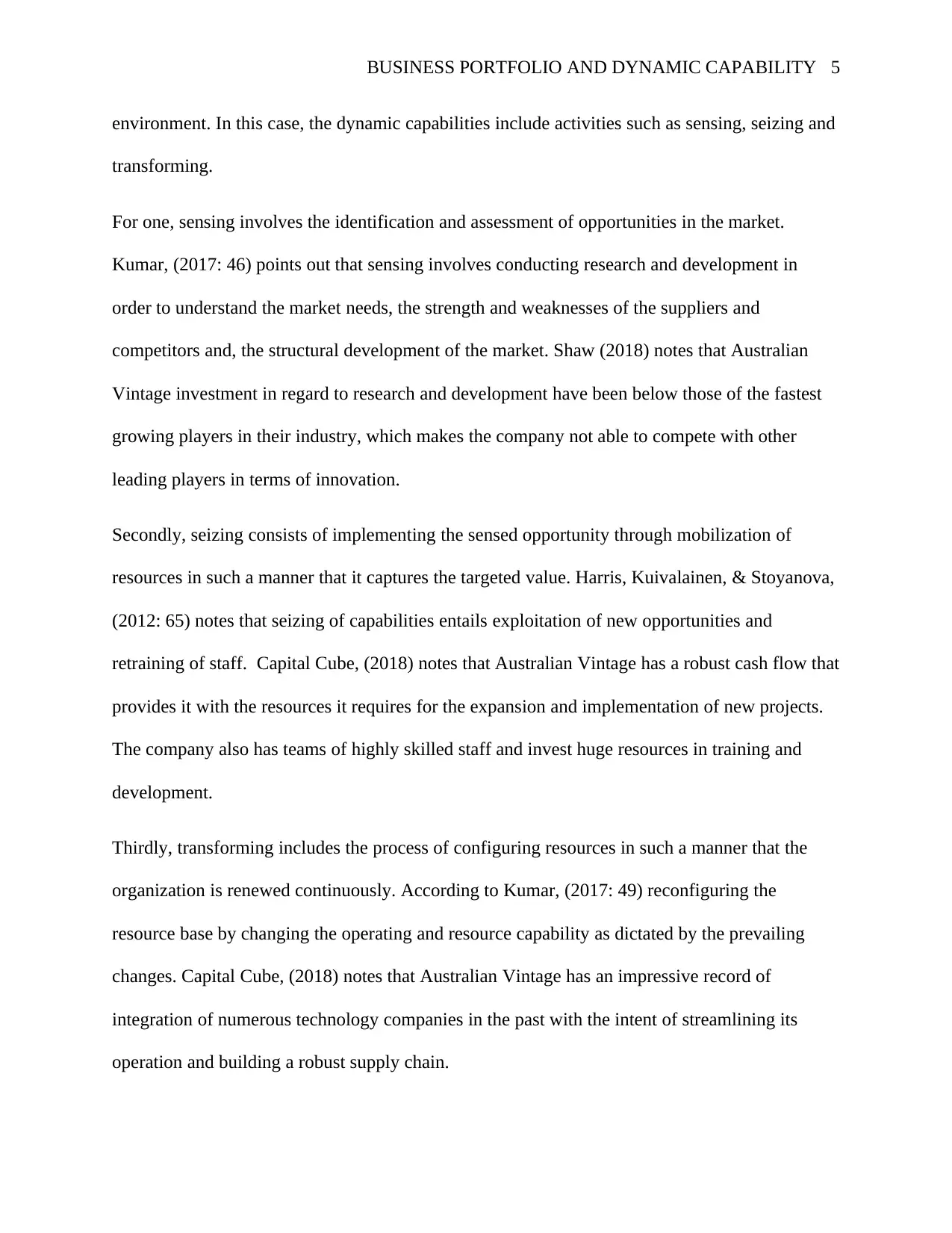
BUSINESS PORTFOLIO AND DYNAMIC CAPABILITY 5
environment. In this case, the dynamic capabilities include activities such as sensing, seizing and
transforming.
For one, sensing involves the identification and assessment of opportunities in the market.
Kumar, (2017: 46) points out that sensing involves conducting research and development in
order to understand the market needs, the strength and weaknesses of the suppliers and
competitors and, the structural development of the market. Shaw (2018) notes that Australian
Vintage investment in regard to research and development have been below those of the fastest
growing players in their industry, which makes the company not able to compete with other
leading players in terms of innovation.
Secondly, seizing consists of implementing the sensed opportunity through mobilization of
resources in such a manner that it captures the targeted value. Harris, Kuivalainen, & Stoyanova,
(2012: 65) notes that seizing of capabilities entails exploitation of new opportunities and
retraining of staff. Capital Cube, (2018) notes that Australian Vintage has a robust cash flow that
provides it with the resources it requires for the expansion and implementation of new projects.
The company also has teams of highly skilled staff and invest huge resources in training and
development.
Thirdly, transforming includes the process of configuring resources in such a manner that the
organization is renewed continuously. According to Kumar, (2017: 49) reconfiguring the
resource base by changing the operating and resource capability as dictated by the prevailing
changes. Capital Cube, (2018) notes that Australian Vintage has an impressive record of
integration of numerous technology companies in the past with the intent of streamlining its
operation and building a robust supply chain.
environment. In this case, the dynamic capabilities include activities such as sensing, seizing and
transforming.
For one, sensing involves the identification and assessment of opportunities in the market.
Kumar, (2017: 46) points out that sensing involves conducting research and development in
order to understand the market needs, the strength and weaknesses of the suppliers and
competitors and, the structural development of the market. Shaw (2018) notes that Australian
Vintage investment in regard to research and development have been below those of the fastest
growing players in their industry, which makes the company not able to compete with other
leading players in terms of innovation.
Secondly, seizing consists of implementing the sensed opportunity through mobilization of
resources in such a manner that it captures the targeted value. Harris, Kuivalainen, & Stoyanova,
(2012: 65) notes that seizing of capabilities entails exploitation of new opportunities and
retraining of staff. Capital Cube, (2018) notes that Australian Vintage has a robust cash flow that
provides it with the resources it requires for the expansion and implementation of new projects.
The company also has teams of highly skilled staff and invest huge resources in training and
development.
Thirdly, transforming includes the process of configuring resources in such a manner that the
organization is renewed continuously. According to Kumar, (2017: 49) reconfiguring the
resource base by changing the operating and resource capability as dictated by the prevailing
changes. Capital Cube, (2018) notes that Australian Vintage has an impressive record of
integration of numerous technology companies in the past with the intent of streamlining its
operation and building a robust supply chain.
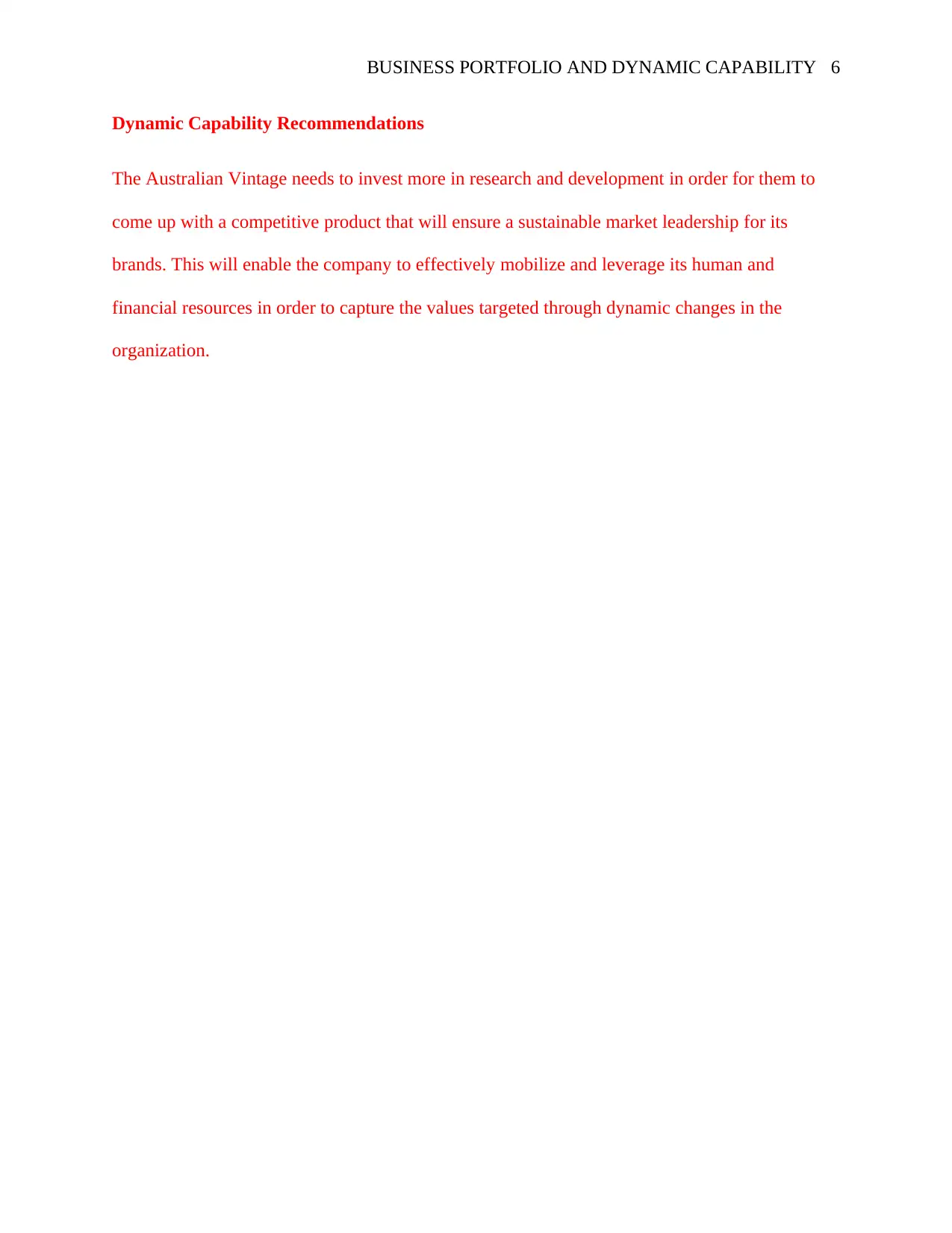
BUSINESS PORTFOLIO AND DYNAMIC CAPABILITY 6
Dynamic Capability Recommendations
The Australian Vintage needs to invest more in research and development in order for them to
come up with a competitive product that will ensure a sustainable market leadership for its
brands. This will enable the company to effectively mobilize and leverage its human and
financial resources in order to capture the values targeted through dynamic changes in the
organization.
Dynamic Capability Recommendations
The Australian Vintage needs to invest more in research and development in order for them to
come up with a competitive product that will ensure a sustainable market leadership for its
brands. This will enable the company to effectively mobilize and leverage its human and
financial resources in order to capture the values targeted through dynamic changes in the
organization.
⊘ This is a preview!⊘
Do you want full access?
Subscribe today to unlock all pages.

Trusted by 1+ million students worldwide
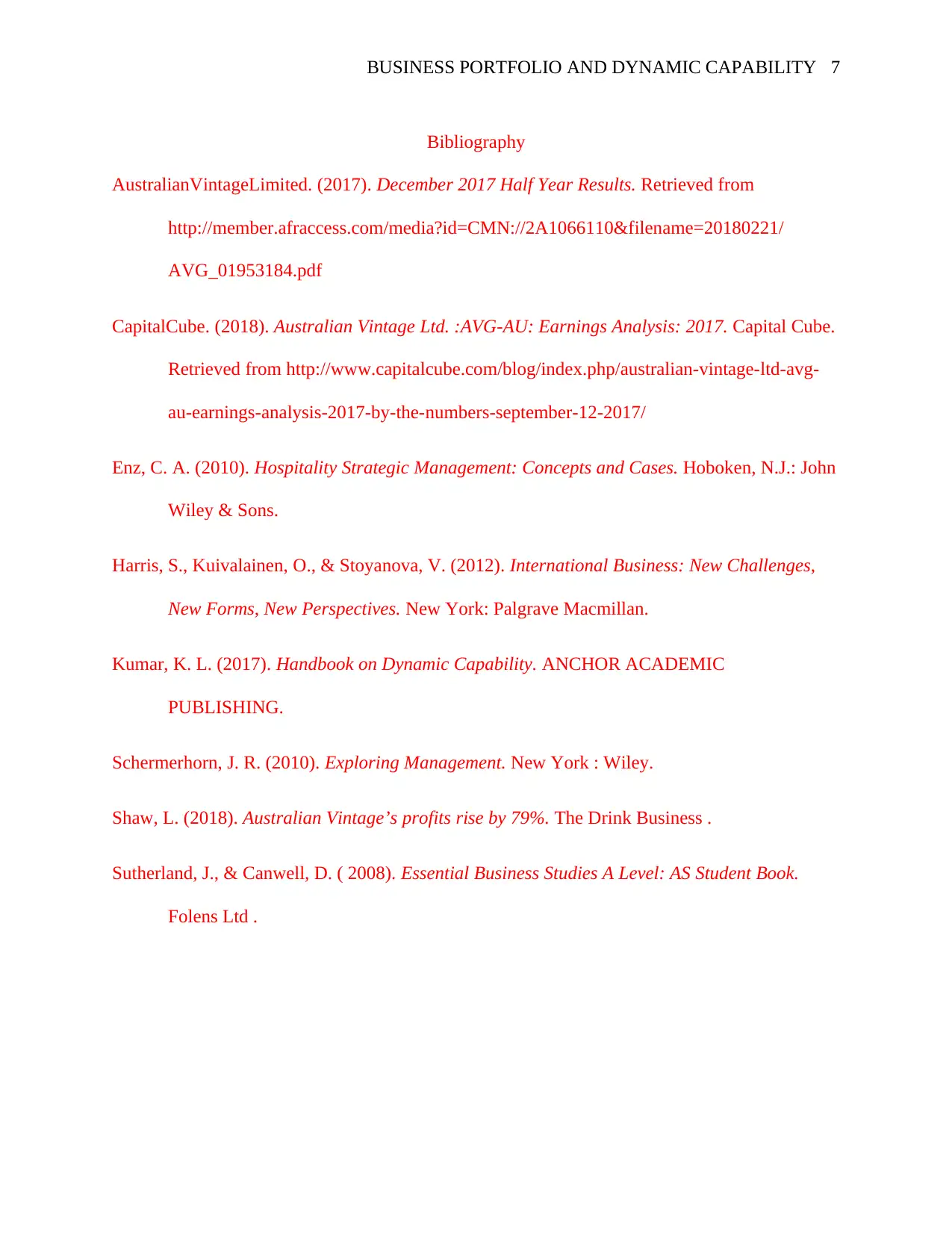
BUSINESS PORTFOLIO AND DYNAMIC CAPABILITY 7
Bibliography
AustralianVintageLimited. (2017). December 2017 Half Year Results. Retrieved from
http://member.afraccess.com/media?id=CMN://2A1066110&filename=20180221/
AVG_01953184.pdf
CapitalCube. (2018). Australian Vintage Ltd. :AVG-AU: Earnings Analysis: 2017. Capital Cube.
Retrieved from http://www.capitalcube.com/blog/index.php/australian-vintage-ltd-avg-
au-earnings-analysis-2017-by-the-numbers-september-12-2017/
Enz, C. A. (2010). Hospitality Strategic Management: Concepts and Cases. Hoboken, N.J.: John
Wiley & Sons.
Harris, S., Kuivalainen, O., & Stoyanova, V. (2012). International Business: New Challenges,
New Forms, New Perspectives. New York: Palgrave Macmillan.
Kumar, K. L. (2017). Handbook on Dynamic Capability. ANCHOR ACADEMIC
PUBLISHING.
Schermerhorn, J. R. (2010). Exploring Management. New York : Wiley.
Shaw, L. (2018). Australian Vintage’s profits rise by 79%. The Drink Business .
Sutherland, J., & Canwell, D. ( 2008). Essential Business Studies A Level: AS Student Book.
Folens Ltd .
Bibliography
AustralianVintageLimited. (2017). December 2017 Half Year Results. Retrieved from
http://member.afraccess.com/media?id=CMN://2A1066110&filename=20180221/
AVG_01953184.pdf
CapitalCube. (2018). Australian Vintage Ltd. :AVG-AU: Earnings Analysis: 2017. Capital Cube.
Retrieved from http://www.capitalcube.com/blog/index.php/australian-vintage-ltd-avg-
au-earnings-analysis-2017-by-the-numbers-september-12-2017/
Enz, C. A. (2010). Hospitality Strategic Management: Concepts and Cases. Hoboken, N.J.: John
Wiley & Sons.
Harris, S., Kuivalainen, O., & Stoyanova, V. (2012). International Business: New Challenges,
New Forms, New Perspectives. New York: Palgrave Macmillan.
Kumar, K. L. (2017). Handbook on Dynamic Capability. ANCHOR ACADEMIC
PUBLISHING.
Schermerhorn, J. R. (2010). Exploring Management. New York : Wiley.
Shaw, L. (2018). Australian Vintage’s profits rise by 79%. The Drink Business .
Sutherland, J., & Canwell, D. ( 2008). Essential Business Studies A Level: AS Student Book.
Folens Ltd .
1 out of 7
Related Documents
Your All-in-One AI-Powered Toolkit for Academic Success.
+13062052269
info@desklib.com
Available 24*7 on WhatsApp / Email
![[object Object]](/_next/static/media/star-bottom.7253800d.svg)
Unlock your academic potential
Copyright © 2020–2025 A2Z Services. All Rights Reserved. Developed and managed by ZUCOL.



